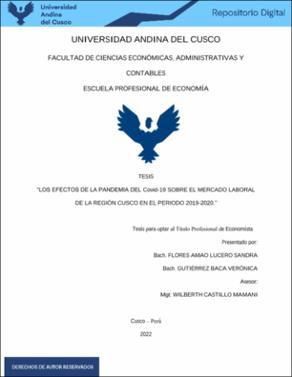| dc.contributor.advisor | Castillo Mamani, Wilberth | |
| dc.contributor.author | Flores Amao, Lucero Sandra | |
| dc.contributor.author | Gutiérrez Baca, Verónica | |
| dc.date.accessioned | 2022-12-26T17:23:06Z | |
| dc.date.available | 2022-12-26T17:23:06Z | |
| dc.date.issued | 2022-09-16 | |
| dc.identifier.uri | https://hdl.handle.net/20.500.12557/5077 | |
| dc.description.abstract | La presente investigación busca medir el impacto que tuvo la pandemia en el mercado
laboral de la región del Cusco en el periodo 2019-2020, con el objetivo de saber cuáles fueron
realmente los indicadores laborales en los que, el Covid-19 tuvo una incidencia significativa. Para
esto se tomó una definición de mercado laboral dividida en tres dimensiones principales: el salario
medio de la región, la oferta laboral de la región definido por las horas de trabajo semanales
promedio y el tipo de empleo considerado como el tipo de contrato de los trabajadores.
Esta investigación es de tipo descriptivo – causal y de alcance cuantitativo, además de tener
un diseño no experimental de corte longitudinal. La información se obtuvo de una base de datos
secundaria, la Encuesta Nacional de Hogares, donde previamente, se determinó un diagnóstico
general de los indicadores laborales de la PET, PEA, Tasa de Inactividad y formalidad a nivel
nacional y regional, esto con el objetivo de describir el contexto situacional en la que se encontraba
el Perú durante pandemia. En cuanto a la pandemia, específicamente se tomó como referencia el
periodo anual de los años 2019 y 2020, para describir un momento pre y post covid-19 en la región
del Cusco, así como el número de defunciones mensuales en la región, ya que es donde se observa
con más claridad el pico de contagios y fallecimientos en Cusco.
Finalmente, para la comprobación de hipótesis se realizó la comparación de medias, en
cada una de las dimensiones medidas. Después de procesar la información y estandarizar los
resultados, se obtuvo del año 2019 al 2020 que: en cuanto al salario medio este disminuyo en S/.
281.22, la oferta laboral disminuyo en 1 hora de trabajo semanal y el tipo de empleo descendió en
10.62% la PEA con contrato de la región. | es_PE |
| dc.description.abstract | The present research seeks to measure the impact that the pandemic had on the labor market
in the Cusco region in the period 2019-2020, with the objective of knowing which were really the
labor indicators in which Covid-19 had a significant incidence. For this, a definition of labor
market was taken divided into three main dimensions: the average salary of the region, the labor
supply of the region defined by the average weekly working hours and the type of employment
considered as the type of contract of the workers.
This research is descriptive-causal and quantitative in scope, in addition to having a non-
experimental longitudinal design. The information was obtained from a secondary database, from
the National Household Survey, where previously, a general diagnosis of the labor indicators of
the PET, EAP, Inactivity Rate, and formality at national and regional level was determined, with
the objective of describing the situational context in which Peru found itself during the pandemic.
Regarding the pandemic, specifically the annual period of 2019 and 2020 was taken as a reference,
to describe a pre and post covid-19 moment in the Cusco region, as well as the number of monthly
deaths in the region, since it is where the peak of infections and deaths in Cusco is most clearly
observed.
Finally, for hypothesis testing, a comparison of means was made for each of the dimensions
measured. After processing the information and standardizing the results, it was obtained from
2019 to 2020 that: the average salary decreased by S/. 281.22, the labor supply decreased by 1
hour of work per week and the type of employment decreased by 10.62% of the EAP with a
contract in the region. | en_US |
| dc.format | application/pdf | es_PE |
| dc.language.iso | spa | es_PE |
| dc.publisher | Universidad Andina del Cusco | es_PE |
| dc.rights | info:eu-repo/semantics/restrictedAccess | es_PE |
| dc.rights.uri | https://creativecommons.org/licenses/by-nc-nd/4.0/ | es_PE |
| dc.subject | Mercado laboral | es_PE |
| dc.subject | Condición laboral | es_PE |
| dc.subject | Covid-19 | es_PE |
| dc.title | Los efectos de la pandemia del Covid-19 sobre el mercado laboral de la región Cusco en el periodo 2019-2020 | es_PE |
| dc.type | info:eu-repo/semantics/bachelorThesis | es_PE |
| thesis.degree.name | Economista | es_PE |
| thesis.degree.grantor | Universidad Andina del Cusco. Facultad de Ciencias Económicas, Administrativas y Contables | es_PE |
| thesis.degree.discipline | Economía | es_PE |
| dc.publisher.country | PE | es_PE |
| dc.subject.ocde | https://purl.org/pe-repo/ocde/ford#5.02.00 | es_PE |
| renati.advisor.dni | 40650638 | |
| renati.advisor.orcid | https://orcid.org/0000-0002-4985-4870 | es_PE |
| renati.author.dni | 70324312 | |
| renati.author.dni | 75238352 | |
| renati.discipline | 311016 | es_PE |
| renati.juror | Beizaga Ramírez, Walter Claudio | |
| renati.juror | Miranda Acuña, Margarita | |
| renati.juror | Serna Góngora, Carlos Axel | |
| renati.juror | Paredes Gordón, Tito Livio | |
| renati.level | https://purl.org/pe-repo/renati/level#tituloProfesional | es_PE |
| renati.type | https://purl.org/pe-repo/renati/type#tesis | es_PE |



